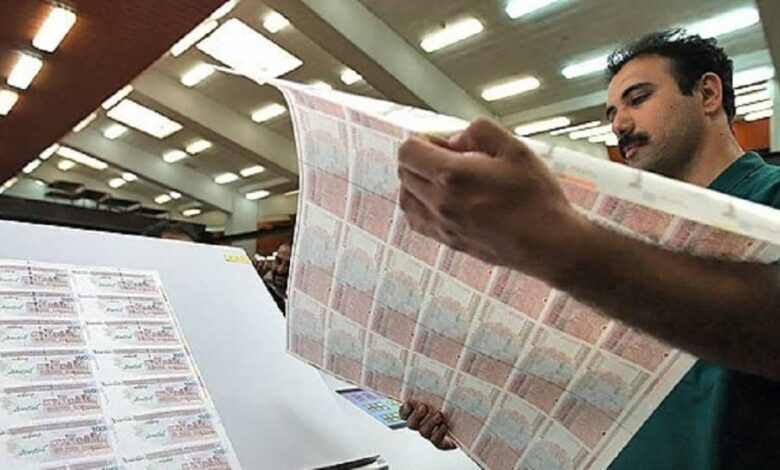The Toll of Unbacked Banknotes: Iran’s Inflation and Suffering

iran banknote printing (1)
Written by
Mahmoud Hakamian
Since becoming the Iranian regime’s president in 2021, Ebrahim Raisi has been making hollow promises and bogus claims about economic reform and prosperity. Yet, bereft of any meaningful or realistic measure for Iran’s financial calamity and being a loyal official of a corrupt establishment that creates and exacerbates the economic dilemma, his words and claims are nothing but pouring salt on people’s wounds.
Thousands of Iranian workers are laid off from work, the country’s inflation soars and the unemployment rate hits records annually. Walls across Iran are adorned with many advertisements by youth and heads of households auctioning their vital body organs to earn their families’ bread.
On August 20, the state-run Etemad online published an infographic acknowledging that prices of at least 12 basic food items have soared in the second year of Raisi’s presidency. According to this outlet, “the cost of poultry has surged by 203%, while meat prices have experienced an even steeper rise of 318%. Likewise, there have been significant hikes in the prices of vegetable oil (328%), pasta (283%), sugar (253%), yogurt (307%), and eggs (161%).”
While the ruling theocracy and its apologists try to blame Iran’s economic crunch on sanctions, regime officials and state media have acknowledged how the corrupt system’s economic policies and financial schemes worsen the current situation. Facing a severe budget shortage, Raisi’s government has increased banknote printing despite its negative effects, notably its role in increasing inflation.
“On a daily basis, a substantial sum of six quadrillion rials is being generated in banknotes. Notably, this monetary influx is distributed in a rather imbalanced manner. Approximately 70% of this newly created money finds its way into the coffers of 8% of the population, leaving only 30% divided among the remaining 99.2%. Consequently, this monetary expansion has resulted in a decline in the purchasing power of the majority while simultaneously exacerbating the socio-economic divide. Consequently, the less privileged are witnessing a further erosion of their financial standing, and even the middle class is experiencing a steady deterioration in their economic status over time,” the state-run ISNA news agency reported on August 20.
What has Ebrahim Raisi achieved in Iran other than economic blunders?
In other words, through unbridled banknote printing, Raisi’s government creates $120,000 worth of liquidity every day based on the current dollar exchange rate. But, as ISNA acknowledged, the created liquidity is given to the 8% elites. Or, the regime’s insiders, primarily the Revolutionary Guards (IRGC), which dominate Iran’s economy, benefit from this huge liquidity.
It is worth noting that printing unbacked banknotes leads to inflation and harms lives. Without tangible support like gold or a stable economy, the currency’s value hinges solely on public trust. Excessive printing floods markets erodes purchasing power, and sends prices soaring. This hits the vulnerable hardest, reducing access to essentials, stifling investments, and lowering the overall quality of life. Hyperinflation across economies underscores the perils of unbridled banknote printing.
In a nutshell, the unscrupulous mass murderer, selected as president overnight by the regime’s supreme leader, has increased Iran’s financial crises, or as the state-run Bahar News website put it on August 25, his government has “distributed poverty. And this is the only thing Raisi’s government has distributed equally.”
On June 13, the regime-affiliated economist Said Lilaz told the state-run Hammihan newspaper that “Since Raisi has become president, we have witnessed the highest amount of liquidity in Iran’s history since the Qajar dynasty and the corrupt government of Nassereddin Shah.” Lilaz acknowledged that this unbridled banknote printing and Raisi’s economic policies are “the absolute plundering of Iran’s economy and people.”
#Iran News in Brief
State-run Jomhuri-e-Eslami daily: "The people are sick and tired of slogans and long for even the slightest action. Beware of the day when the army of the hungry rises against you. What the people are not willing to tolerate is #discrimination. They do not… pic.twitter.com/wRPSFz4qe3— NCRI-FAC (@iran_policy) July 17, 2023
As the anniversary of Iran’s major uprising in 2022 approaches, it is safe to say that the regime is playing with fire by increasing the current economic crises and should await its results. As another state-affiliated economist, Hossein Raghfar, warned on March 10, 2023, “We should fear the army of starving people. The situation will reach a point when they pour onto the streets, and there will be no force in the universe to stop them.”

